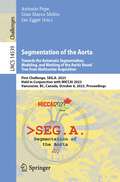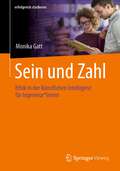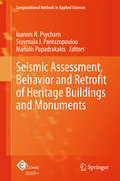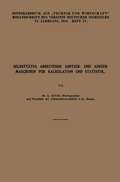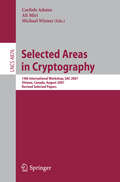- Table View
- List View
Seeking the Truth from Mobile Evidence: Basic Fundamentals, Intermediate and Advanced Overview of Current Mobile Forensic Investigations
by John BairSeeking the Truth from Mobile Evidence: Basic Fundamentals, Intermediate and Advanced Overview of Current Mobile Forensic Investigations will assist those who have never collected mobile evidence and augment the work of professionals who are not currently performing advanced destructive techniques. This book is intended for any professional that is interested in pursuing work that involves mobile forensics, and is designed around the outcomes of criminal investigations that involve mobile digital evidence. Author John Bair brings to life the techniques and concepts that can assist those in the private or corporate sector. Mobile devices have always been very dynamic in nature. They have also become an integral part of our lives, and often times, a digital representation of where we are, who we communicate with and what we document around us. Because they constantly change features, allow user enabled security, and or encryption, those employed with extracting user data are often overwhelmed with the process. This book presents a complete guide to mobile device forensics, written in an easy to understand format. Provides readers with basic, intermediate, and advanced mobile forensic concepts and methodologyThirty overall chapters which include such topics as, preventing evidence contamination, triaging devices, troubleshooting, report writing, physical memory and encoding, date and time stamps, decoding Multi-Media-Messages, decoding unsupported application data, advanced validation, water damaged phones, Joint Test Action Group (JTAG), Thermal and Non-Thermal chip removal, BGA cleaning and imaging, In-System-Programming (ISP), and morePopular JTAG boxes – Z3X and RIFF/RIFF2 are expanded on in detailReaders have access to the companion guide which includes additional image examples, and other useful materials
Segmentation and Recovery of Superquadrics (Computational Imaging and Vision #20)
by Ales Jaklic Ales Leonardis F. SolinaA representation of objects by their parts is the dominant strategy for representing complex 3D objects in many disciplines. In computer vision and robotics, superquadrics are among the most widespread part models. Superquadrics are a family of parametric models that cover a wide variety of smoothly changing 3D symmetric shapes, which are controlled with a small number of parameters and which can be augmented with the addition of global and local deformations. The book covers, in depth, the geometric properties of superquadrics. The main contribution of the book is an original approach to the recovery and segmentation of superquadrics from range images. Several applications of superquadrics in computer vision and robotics are thoroughly discussed and, in particular, the use of superquadrics for range image registration is demonstrated. Audience: The book is intended for readers of all levels who are familiar with and interested in computer vision issues.
Segmentation and Separation of Overlapped Latent Fingerprints: Algorithms, Techniques, and Datasets (SpringerBriefs in Computer Science)
by Branka Stojanović Oge Marques Aleksandar NeškovićThis Springerbrief presents an overview of problems and technologies behind segmentation and separation of overlapped latent fingerprints, which are two fundamental steps in the context of fingerprint matching systems. It addresses five main aspects: (1) the need for overlapped latent fingerprint segmentation and separation in the context of fingerprint verification systems; (2) the different datasets available for research on overlapped latent fingerprints; (3) selected algorithms and techniques for segmentation of overlapped latent fingerprints; (4) selected algorithms and techniques for separation of overlapped latent fingerprints; and (5) the use of deep learning techniques for segmentation and separation of overlapped latent fingerprints.By offering a structured overview of the most important approaches currently available, putting them in perspective, and suggesting numerous resources for further exploration, this book gives its readers a clear path for learning new topics and engaging in related research. Written from a technical perspective, and yet using language and terminology accessible to non-experts, it describes the technologies, introduces relevant datasets, highlights the most important research results in each area, and outlines the most challenging open research questions.This Springerbrief targets researchers, professionals and advanced-level students studying and working in computer science, who are interested in the field of fingerprint matching and biometrics. Readers who want to deepen their understanding of specific topics will find more than one hundred references to additional sources of related information.
Segmentation, Classification, and Registration of Multi-modality Medical Imaging Data: MICCAI 2020 Challenges, ABCs 2020, L2R 2020, TN-SCUI 2020, Held in Conjunction with MICCAI 2020, Lima, Peru, October 4–8, 2020, Proceedings (Lecture Notes in Computer Science #12587)
by Nadya Shusharina Mattias P. Heinrich Ruobing HuangThis book constitutes three challenges that were held in conjunction with the 23rd International Conference on Medical Image Computing and Computer-Assisted Intervention, MICCAI 2020, in Lima, Peru, in October 2020*: the Anatomical Brain Barriers to Cancer Spread: Segmentation from CT and MR Images Challenge, the Learn2Reg Challenge, and the Thyroid Nodule Segmentation and Classification in Ultrasound Images Challenge.The 19 papers presented in this volume were carefully reviewed and selected form numerous submissions. The ABCs challenge aims to identify the best methods of segmenting brain structures that serve as barriers to the spread of brain cancers and structures to be spared from irradiation, for use in computer assisted target definition for glioma and radiotherapy plan optimization. The papers of the L2R challenge cover a wide spectrum of conventional and learning-based registration methods and often describe novel contributions. The main goal of the TN-SCUI challenge is to find automatic algorithms to accurately segment and classify the thyroid nodules in ultrasound images. *The challenges took place virtually due to the COVID-19 pandemic.
Segmentation of the Aorta. Towards the Automatic Segmentation, Modeling, and Meshing of the Aortic Vessel Tree from Multicenter Acquisition: First Challenge, SEG.A. 2023, Held in Conjunction with MICCAI 2023, Vancouver, BC, Canada, October 8, 2023, Proceedings (Lecture Notes in Computer Science #14539)
by Antonio Pepe Gian Marco Melito Jan EggerThis book constitutes the First Segmentation of the Aorta Challenge, SEG.A. 2023, which was held in conjunction with the 26th International Conference on Medical Image Computing and Computer-Assisted Intervention, MICCAI 2023, on October 8, 2023. The 8 full and 3 short papers presented have been carefully reviewed and selected for inclusion in the book. They focus specifically on robustness, visual quality and meshing of automatically generated segmentations of aortic vessel trees from CT imaging. The challenge was organized as a ”container submission” challenge, where participants had to upload their algorithms to Grand Challenge in the form of Docker containers. Three tasks were created for SEG.A. 2023.
Sehen und Photographie: Ästhetik und Bild (X.media.press)
by Marlene Schnelle-SchneyderWir wissen heute, dass das Sehen ein sehr komplexer Prozess ist, der zwischen Auge und Gehirn abläuft. Damit stellen sich neue Fragen an die Rezeption von Bildern. Wann und wie aktivieren Bilder unsere visuelle Wahrnehmung? Der Band enthält viele Bildbeispiele, anhand derer getestet werden kann, was wir sehen und wie wir sehen. Die aktualisierte und erweiterte Neuauflage behandelt u. a. das Thema Spiegelneuronen und diskutiert vor dem Hintergrund ihrer Entdeckung die Interaktion von Bild und Betrachter, von Nachempfindung und Emotionen.
Sein und Zahl: Ethik in der Künstlichen Intelligenz für Ingenieur*innen (erfolgreich studieren)
by Monika GattKünstliche Intelligenz, der Transhumanismus fordert die Menschen in ganz neuer Weise heraus. Wir brauchen eine neue, interdisziplinäre Ethik. Sprachsensible Software wie Siri und Alexa werden in unseren Lebensalltag integriert, im autonomen Fahren werden Entscheidungen über Leben und Tod einer künstlichen Intelligenz übertragen. Durch die Aufzeichnung von menschlichem Verhalten soll die Kommunikation mit Verstorbenen ermöglicht werden. Wie stehen wir ethisch zu maschine learning? Wer trägt die Verantwortung? Was darf KI? Um diese Frage zu beantworten, werden in Sein und Zahl ethische und moralische Grundbegriffe wie die Unantastbarkeit menschlicher Würde, Freiheit und Pflichten in Beziehung zu den großen aktuellen Themen der Ingenieurswissenschaften gesetzt.
Seismic Assessment, Behavior and Retrofit of Heritage Buildings and Monuments (Computational Methods in Applied Sciences #37)
by Ioannis N. Psycharis Stavroula J. Pantazopoulou Manolis PapadrakakisThis book assembles, identifies and highlights the most recent developments in Rehabilitation and retrofitting of historical and heritage structures. This is an issue of paramount importance in countries with great built cultural heritage that also suffer from high seismicity, such as the countries of the eastern Mediterranean basin. Heritage structures range from traditional residential constructions to monumental structures, ancient temples, towers, castles, etc. It is generally recognized that these structures present particular difficulties in seismic response calculation through computer simulation due to the complexity of the structural system which is, generally, inhomogeneous, with several contact problems, gaps/joints, nonlinearities and brittleness in material constituents. This book contains selected papers from the ECCOMAS Thematic Conferences on Computational Methods in Structural Dynamics & Earthquake Engineering (COMPDYN) that were held in Corfu, Greece in 2011 and Kos, Greece in 2013. The Conferences brought together the scientific communities of Computational Mechanics, Structural Dynamics and Earthquake Engineering in an effort to facilitate the exchange of ideas in topics of mutual interest and to serve as a platform for establishing links between research groups with complementary activities.
Seismic Modelling and Pattern Recognition in Oil Exploration
by A. SinvhalThe reasons for writing this book are very simple. We use and teach com puter aided techniques of mathematical simulation and of pattern recogni tion. Life would be much simpler if we had a suitable text book with methods and computer programmes which we could keep referring to. Therefore, we have presented here material that is essential for mathematical modelling of some complex geological situations, with which earth scientists are often confronted. The reader is introduced not only to the essentials of computer modelling, data analysis and pattern recognition, but is also made familiar with the basic understanding with which they can plunge into when solving related and more complex problems. This book first makes a case for seismic stratigraphy and then for pattern recognition. Chapter 1 provides an extensive review of applications of pattern recognition methods in oil exploration. Simulation procedures are presented with examples that are fairly simple to understand and easy to use on the computer. Several geological situations can be formulated and simulated using the Monte Carlo method. The binary lithologic sequences, discussed in Chapter 2, consist of alternating layers of any two of sand, shale and coal.
Seismic Performance Analysis of Concrete Gravity Dams (Advanced Topics in Science and Technology in China #57)
by Gaohui Wang Wenbo Lu Sherong ZhangThis book evaluates the seismic performance of concrete gravity dams, considering the effects of strong motion duration, mainshock-aftershock seismic sequence, and near-fault ground motion. It employs both the extended finite element method (XFEM) and concrete damaged plasticity (CDP) models to characterize the mechanical behavior of concrete gravity dams under strong ground motions, including the dam-reservoir-foundation interaction. In addition, it discusses the effects of the initial crack, earthquake direction, and cross-stream seismic excitation on the nonlinear dynamic response to strong ground motions, and on the damage-cracking risk of concrete gravity dams.This book provides a theoretical basis for the seismic performance evaluation of high dams, and can also be used as a reference resource for researchers and graduate students engaged in the seismic design of high dams.
Seismic Wave Propagation in Non-Homogeneous Elastic Media by Boundary Elements (Solid Mechanics and Its Applications #240)
by George D. Manolis Petia S. Dineva Tsviatko V. Rangelov Frank WuttkeThis book focuses on the mathematical potential and computational efficiency of the Boundary Element Method (BEM) for modeling seismic wave propagation in either continuous or discrete inhomogeneous elastic/viscoelastic, isotropic/anisotropic media containing multiple cavities, cracks, inclusions and surface topography. BEM models may take into account the entire seismic wave path from the seismic source through the geological deposits all the way up to the local site under consideration.The general presentation of the theoretical basis of elastodynamics for inhomogeneous and heterogeneous continua in the first part is followed by the analytical derivation of fundamental solutions and Green's functions for the governing field equations by the usage of Fourier and Radon transforms. The numerical implementation of the BEM is for antiplane in the second part as well as for plane strain boundary value problems in the third part. Verification studies and parametric analysis appear throughout the book, as do both recent references and seminal ones from the past.Since the background of the authors is in solid mechanics and mathematical physics, the presented BEM formulations are valid for many areas such as civil engineering, geophysics, material science and all others concerning elastic wave propagation through inhomogeneous and heterogeneous media.The material presented in this book is suitable for self-study. The book is written at a level suitable for advanced undergraduates or beginning graduate students in solid mechanics, computational mechanics and fracture mechanics.
Selbsteinstellende, Modellgestützte Regelung Eines Industrieroboters (Fortschritte der Robotik #13)
by Guido SeegerSelbstreguliertes Lernen mit mobil nutzbaren Technologien: Lernstrategien in der beruflichen Weiterbildung
by Sandra SchulzSandra Schulz untersucht, wie Lernende den Erfordernissen selbstgesteuerten Lernens gegenübertreten und wie sie ihren Lernprozess selbstreguliert gestalten. Die Fähigkeit des selbstgesteuerten Lernens ist eine Anforderung der Bildungs- und Arbeitswelt und damit gleichzeitig eine Schlüsselkompetenz in der Informationsgesellschaft. Da insbesondere den neuen Lerntechnologien zugesprochen wird, selbstgesteuertes Lernen zu fördern, betrachtet die Autorin detailliert den Selbstregulationsprozess beim Lernen mit mobilen Technologien. Auf Grundlage einer empirischen Studie diskutiert sie Aspekte des Lernhandelns und Lernstrategie-Einsatzes. Ihre Ergebnisse geben Aufschluss über den Prozess des selbstregulierten Lernens beim Einsatz von Tablets in der betrieblichen Weiterbildung, wobei auch die emotionalen Bedingungen des Lernens berücksichtigen werden.
Selbsttätig Arbeitende Sortier- und Addiermaschinen für Kalkulation und Statistik
by Lorenz LucasDieser Buchtitel ist Teil des Digitalisierungsprojekts Springer Book Archives mit Publikationen, die seit den Anfängen des Verlags von 1842 erschienen sind. Der Verlag stellt mit diesem Archiv Quellen für die historische wie auch die disziplingeschichtliche Forschung zur Verfügung, die jeweils im historischen Kontext betrachtet werden müssen. Dieser Titel erschien in der Zeit vor 1945 und wird daher in seiner zeittypischen politisch-ideologischen Ausrichtung vom Verlag nicht beworben.
Selected Applications of Convex Optimization (Springer Optimization and Its Applications #103)
by Li LiThis book focuses on the applications of convex optimization and highlights several topics, including support vector machines, parameter estimation, norm approximation and regularization, semi-definite programming problems, convex relaxation, and geometric problems. All derivation processes are presented in detail to aid in comprehension. The book offers concrete guidance, helping readers recognize and formulate convex optimization problems they might encounter in practice.
Selected Areas in Cryptography: 14th International Workshop, SAC 2007, Ottawa, Canada, August 16-17, 2007, Revised Selected Papers (Lecture Notes in Computer Science #4876)
by Carlisle Adams Ali Miri Michael WienerHere, more than two dozen papers on some of the latest subject areas in cryptography have been selected for publication. They represent the refereed post-proceedings of the 14th International Workshop on Selected Areas in Cryptography, SAC 2007, held in Ottawa, Canada, in August 2007. Chosen from more than 70 submissions, they cover a huge array of topics including stream cipher cryptanalysis, modes of operation and side-channel attacks. Online files and updates are included.
Selected Areas in Cryptography: 28th International Conference, Virtual Event, September 29 – October 1, 2021, Revised Selected Papers (Lecture Notes in Computer Science #13203)
by Riham AlTawy Andreas HülsingThis book contains revised selected papers from the 28th International Conference on Selected Areas in Cryptography, SAC 2021, held as a virtual event September and October 2021.* The 23 full papers presented in this volume were carefully reviewed and selected from 60 submissions. They cover the following research areas: design and analysis of symmetric key primitives and cryptosystems, including block and stream ciphers, hash functions, MAC algorithms, and authenticated encryption schemes, efficient implementations of symmetric and public key algorithms, mathematical and algorithmic aspects of applied cryptology, and secure elections and related cryptographic constructions. *The conference was originally planned to take place at the University of Victoria, BC, Canada. Due to the COVID-19 pandemic, it was held virtually.
Selected Areas in Cryptography: 15th Annual International Workshop, SAC 2008, Sackville, New Brunswick, Canada, August 14-15, 2008 (Lecture Notes in Computer Science #5381)
by Roberto Avanzi Liam Keliher Francesco SicaSelected Areas in Cryptography: 13th International Workshop, SAC 2006, Montreal, Canada, August 17-18, 2006, Revised Selected Papers (Lecture Notes in Computer Science #4356)
by Eli Biham Amr M. YoussefThis volume constitutes the refereed post-proceedings of the 13th International Workshop on Selected Areas in Cryptography. Twenty-five full papers are presented along with two important invited talks. The papers are organized into topical sections covering block cipher cryptanalysis, stream cipher cryptanalysis, block and stream ciphers, side-channel attacks, efficient implementations, message authentication codes, and hash functions.
Selected Areas in Cryptography: 17th International Workshop, SAC 2010, Waterloo, Ontario, Canada, August 12-13, 2010, Revised Selected Papers (Lecture Notes in Computer Science #6544)
by Alex Biryukov Guang Gong Douglas R. StinsonThis book constitutes the thoroughly refereed post-proceedings of the 17th Annual International Workshop on Selected Areas in Cryptography, SAC 2010, held in Waterloo, Ontario, Canada in August 2010. The 24 revised full papers presented together with 2 invited papers were carefully reviewed and selected from 90 submissions. The papers are organized in topical sections on hash functions, stream ciphers, efficient implementations, coding and combinatorics, block ciphers, side channel attacks, and mathematical aspects.
Selected Areas in Cryptography: 27th International Conference, Halifax, NS, Canada (Virtual Event), October 21-23, 2020, Revised Selected Papers (Lecture Notes in Computer Science #12804)
by Orr Dunkelman Michael J. Jacobson Jr. Colin O’FlynnThis book contains revised selected papers from the 27th International Conference on Selected Areas in Cryptography, SAC 2020, held in Halifax, Nova Scotia, Canada in October 2020. The 27 full papers presented in this volume were carefully reviewed and selected from 52 submissions. They cover the following research areas: design and analysis of symmetric key primitives and cryptosystems, including block and stream ciphers, hash functions, MAC algorithms, and authenticated encryption schemes, efficient implementations of symmetric and public key algorithms, mathematical and algorithmic aspects of applied cryptology, and secure elections and related cryptographic constructions
Selected Areas in Cryptography: 11th International Workshop, SAC 2004, Waterloo, Canada, August 9-10, 2004, Revised Selected Papers (Lecture Notes in Computer Science #3357)
by Helena Handschuh Anwar HasanSAC 2004 was the eleventh in a series of annual workshops on Selected Areas in Cryptography. This was the second time that the workshop was hosted by the University of Waterloo, Ontario, with previous workshops being held at Queen’sUniversityinKingston(1994,1996,1998and1999),CarletonUniversity in Ottawa (1995, 1997 and 2003), the Fields Institute in Toronto (2001) and Memorial University of Newfoundland in St. John’s (2002). The primary intent of the workshop was to provide a relaxed atmosphere in which researchers in cryptography could present and discuss new work on selected areas of current interest. This year’s themes for SAC were: – Design and analysis of symmetric key cryptosystems. – Primitives for symmetric key cryptography, including block and stream - phers, hash functions, and MAC algorithms. – E?cient implementation of cryptographic systems in public and symmetric key cryptography. – Cryptographic solutions for mobile (web) services. A record of 117 papers were submitted for consideration by the program committee. After an extensive review process, 25 papers were accepted for p- sentation at the workshop (two of these papers were merged). Unfortunately, many good papers could not be accommodated this year. These proceedings contain the revised versions of the 24 accepted papers. The revised versions were not subsequently checked for correctness. Also, we were very fortunate to have two invited speakers at SAC 2004. • Eli Biham arranged for some breaking news in his talk on “New Results on SHA-0 and SHA-1.” This talk was designated as the Sta?ord Tavares L- ture.
Selected Areas in Cryptography: 6th Annual International Workshop, SAC'99 Kingston, Ontario, Canada, August 9-10, 1999 Proceedings (Lecture Notes in Computer Science #1758)
by Howard Heys Carlisle AdamsSelected Areas in Cryptography: 16th International Workshop, SAC 2009, Calgary, Alberta, Canada, August 13-14, 2009, Revised Selected Papers (Lecture Notes in Computer Science #5867)
by Michael J. Jacobson Vincent Rijmen Rei Safavi-NainiThe 16th Workshop on Selected Areas in Cryptography (SAC 2009) was held at the University of Calgary,in Calgary, Alberta, Canada, during August 13-14, 2009. There were 74 participants from 19 countries. Previous workshops in this series were held at Queens University in Kingston (1994, 1996, 1998, 1999, and 2005), Carleton University in Ottawa (1995, 1997, and 2003), University of - terloo (2000 and 2004), Fields Institute in Toronto (2001), Memorial University of Newfoundland in St. Johns (2002), Concordia University in Montreal (2006), University of Ottawa (2007), and Mount Allison University in Sackville (2008). The themes for SAC 2009 were: 1. Design and analysis of symmetric key primitives and cryptosystems, incl- ing block and stream ciphers, hash functions, and MAC algorithms 2. E?cient implementations of symmetric and public key algorithms 3. Mathematical and algorithmic aspects of applied cryptology 4. Privacy enhancing cryptographic systems This included the traditional themes (the ?rst three) together with a special theme for 2009 workshop (fourth theme).




